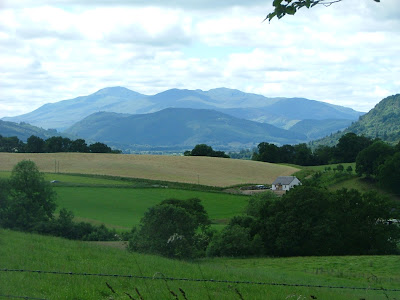
Tuesday, 28 July 2009
The Birks of Aberfeldy

Robert Burns wrote his famous poem about Aberfeldy while sitting here on a short visit to the town. You can imagine people everywhere wanting him to write a poem every time he visited somewhere.........I wonder if it ever became a chore, or did this sort of poem only take a matter of seconds to some-one who was as practiced as this.
"While o'er their heads the hazels hing,
The little birdies blythly sing.
Or lightly flit on wanton wing,
In the Birks of Aberfeldy."
Thursday, 23 July 2009
Going up........

Some of our native wildlife like this red squirel will use a mixture of native and non-native trees to supply their various needs, depending on what is available in a given area. This red squirrel is climbing up a non-native Wellingtonia, a substitute in this instance for the native Scots Pine.
Photo submitted by Kristina Hayward.
Wednesday, 22 July 2009
Walk along a hedgerow

Many of our native trees and shrubs can be found growing in hedgerows. The small % of our land area that is covered in native trees is widely documented, but trees and shrubs in these linear features are often forgotten about, yet they add significantly to the overall resource. Crucially, they often link together other woodland habitats, and provide a rich source of food for birds throughout the winter as they provide protection from grazing to a wide variety of flowering and seeding plants.
All the trees, shrubs and woody plants below were recorded in a walk along a 100 metre stretch of hedgerow.
Part of the landscape........

These hedges have been allowed to grow up and mature. Typically, those alongside roads are cut back on an annual basis on safety grounds, to maintain lines of vision. These mature hedges are an excellent source of firewood, and shelter for animals, as well as providing stock-proof boundaries, defining field and ownership boundaries, and providing a whole host of food supplies for birds and other animals.
Hawthorn
Scotch thistles
Saturday, 18 July 2009
Controlling Himalayan balsam

Scottish Native Woods is managing a project to reduce the presence of invasive non-native plants in Glenurquhart, Highland. In particular, Urquhart Bay Woods SSSI harbours significant colonies of Japanese knotweed, Himalayan balsam and White butterbur. Knotweed and butterbur are perennials best tackled by spraying, but balsam is an annual. We are aiming to prevent it from flowering and setting seed this summer. We hope to eradicate it from the catchment by 2011.
Cutting balsam
Before ...

This stand was chosen for a small trial. The area was divided into 3 sections. One was cut at about ankle to knee height (very quick), the next below the first node, i.e. close to the ground (a bit slower), and the third by pulling (very slow). The site will be visited again in a couple of weeks to assess the results. Watch this space!
During ...
Wanted .... Help!

Part of Urquhart Bay Woods is owned by Woodland Trust Scotland. There is a network of paths which are used by local residents and holidaying visitors. This presents a perfect opportunity to raise awareness of the problem with invasive non-native species. Within a week of putting up these signs, almost all the balsam along the footpaths had been uprooted and placed in the containers we provided. People power!
Tuesday, 14 July 2009
Volunteer day - building a tree nursery
Growing Up With Trees - Weeding the tree nursery
Friday, 10 July 2009
Barley in the middle........
Looking up to Faragon
Wednesday, 8 July 2009
honeysuckle
Monday, 6 July 2009
What's this......??

Scotland's forests used to be home to this animal, the European bison, pictured here at the Highland Wildlife Park near Kincraig. They were hunted to extinction, surviving only in captivity in collections and zoos. The last wild European bison was shot in Poland........the last in Scotland was shot about 700 years ago. The Eurpean bison is slightly smaller than the American one, also virtually exterminated in the 19th century.
Was it because they are so ugly......??
Wednesday, 1 July 2009
shelter from the heat
Subscribe to:
Comments (Atom)








































